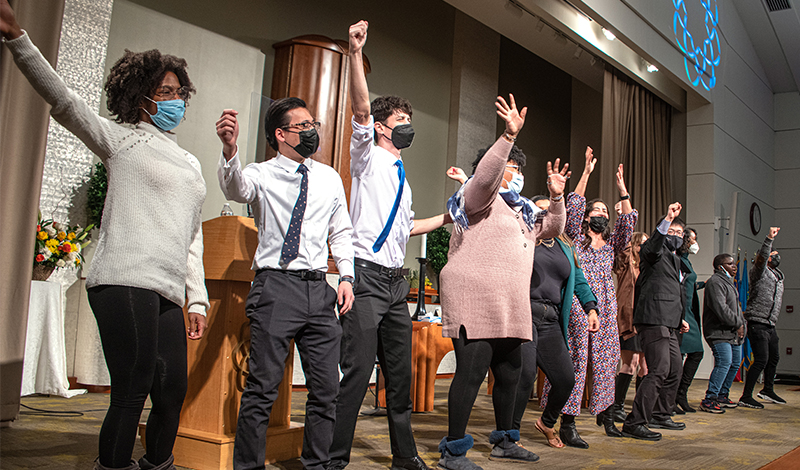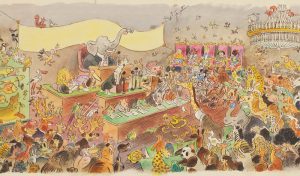The following text is excerpted from Ikeda Sensei’s lecture on “The Strategy of the Lotus Sutra,” which can be found in Learning from the Writings: The Hope-filled Teachings of Nichiren Daishonin, pp. 143–44.
In its original sense, the term strategy refers to battle tactics, the science of warfare or martial arts. Considered more broadly, it can be taken to mean a method for achieving better results in all areas, for leading a victorious life of value creation.
The “strategy of the Lotus Sutra” refers to faith in the Gohonzon. It is faith that battles ignorance and delusion, breaks through negative karma and wins without fail through confident prayer and the boundless wisdom and courage that flow forth as a result.
No matter what the situation, when we base ourselves on the Mystic Law, the ultimate Law of the universe, we will never be deadlocked. The unparalleled power of the Mystic Law enables us to overcome all obstacles or enemies that hinder us on the path to attaining Buddhahood. Nichiren Daishonin cites the passage from the “Medicine King” chapter of the Lotus Sutra: “All others who bear you enmity or malice will likewise be wiped out”[1] (WND-1, 1001). These words indicate one example of the immense good fortune that comes from embracing and propagating the Lotus Sutra. Having the ability to defeat all obstacles and negative forces through faith in the Mystic Law is the power of the “strategy of the Lotus Sutra.”
Hence, Nichiren indicates that the “strategy of the Lotus Sutra” is in fact the essence of the “strategy and swordsmanship” that allowed Shijo Kingo to emerge unscathed and victorious from his encounter with enemies (see WND-1, 1001).
The foundation of all of our efforts, endeavors and challenges—whether in the realm of staying healthy, leading a fulfilling life or showing actual proof of winning trust in the community and in society—is the strategy of the Lotus Sutra, or, in other words, strong faith.
At the end of his letter to Shijo Kingo, the Daishonin writes: “Have profound faith. A coward cannot have any of his prayers answered” (WND-1, 1001).
“Cowardice shuts the eyes”—this was the insight of the 19th-century American Renaissance philosopher Ralph Waldo Emerson. Cowardice prevents us from seeing the truth, from seeing things as they are. It can cause even a minor hardship to seem like a huge, immovable obstacle and make even the door to a solution appear instead like a thick wall. Courage is, therefore, crucial.
Emerson says something very interesting: “It is plain that there is no separate essence called courage, no cup or cell in the brain, no vessel in the heart containing drops or atoms that make or give this virtue; but [courage] is the right or healthy state of every man, when he is free to do that which is constitutional to him to do. It is directness—the instant performing of that which he ought.” In terms of Buddhism, courage indicates the soundest and most robust spirit that derives from our inherent Buddha nature, which could be described as our most “healthy state”; it means the fighting spirit to vanquish our fundamental darkness and instantly reveal our enlightened Dharma nature.
For us, courage means challenging the real-life issues confronting us right where we are with the belief that we ourselves are entities of the Mystic Law. This is the way to employ the strategy of the Lotus Sutra and construct an indestructible history of victory and glory.
As a young man working under Mr. Toda, I battled various hardships. Whenever I reached an impasse, I would chant Nam-myoho-renge-kyo to break through. I would chant and challenge myself afresh. Determined to win victory for my mentor and for kosen-rufu, I fiercely pitted myself each day against one obstacle after another. And in the end, I triumphed over all adversity.
“For my mentor!” “For kosen-rufu!”—when youth strive with this strong resolve to reply to their mentor and contribute to kosen-rufu, they can bring forth their true full potential and ability. This, from my personal experience, is the “strategy of the Lotus Sutra.”
In order to realize Mr. Toda’s vision, I exerted myself on the front lines of countless hard-fought battles, and as a result, I came to understand the true meaning of faith that brings absolute victory. During the 11 years that I served my mentor, I showed unequivocal actual proof of victory based on the “strategy of the Lotus Sutra.” This brought Mr. Toda great joy.
The time has now come for me to entrust this practical philosophy for certain victory to my genuine disciples. Just as Mr. Toda called out 55 years ago, I call out to all the youth who are my true successors: “My young friends, how will you accomplish kosen-rufu? What are the challenges that lie before you? Where and how will you fight and win?”
References
- See The Lotus Sutra and Its Opening and Closing Sutras, p. 329 ↩︎
You are reading {{ meterCount }} of {{ meterMax }} free premium articles





